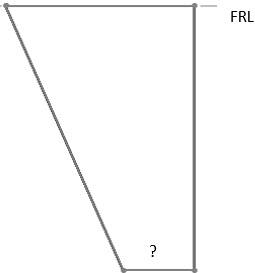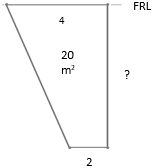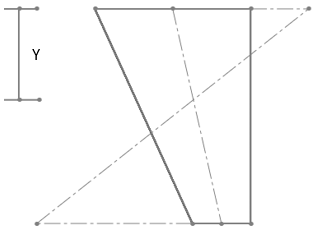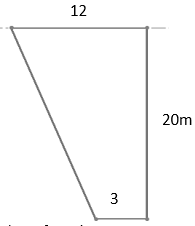This set of Aircraft Design Multiple Choice Questions & Answers (MCQs) focuses on “Configuration Layout – Wing/Tail Layout and Loft-1”.
1. A wing is to be loft with span as 2m and reference area of wing is 4m2. If we want to design the wing with taper ratio of 0.6 then what will be the value of root chord?
a) 2.5m
b) 2.50m
c) 2.65m
d) 25.6m
View Answer
Explanation: Given, span b=2m, area S = 4m2, taper ratio t = 0.6
Now, root chord Cr is given by,
Cr = 2*s / b (1+t) = 2*4 / 2(0.6+1) = 8/2*1.6 = 2.5m.
2. Term marked by ’?’ in diagram is ________

a) tip chord
b) root chord
c) thrust
d) lift
View Answer
Explanation: Typical wing planform is shown in figure. Chord at the fuselage section is called root chord. Chord at wing tip is called tip chord. Thrust is a propulsive force. Lift is an upward force.
3. Consider below wing. Calculate the value of span of wing marked by ‘?’.

a) 3.3m
b) 6.66m
c) 3.36m
d) 6.96m
View Answer
Explanation: Given, Cr = 4m, Ct = 2m, S = 20m2
Taper ratio t = Ct/Cr = 2/4 = 0.5.
Hence, wing span of given wing b/2 = S/Cr*(1+t) = 20/4*(1+0.5) = 20/4*1.5 = 3.3m.
4. Let’s consider flat wrapping is to be used for lofting. If wing has taper ratio of 0.4, span of 26.6ft and root chord Cr is 76in then, find the area to be covered by flat wrapping.
a) 118ft2
b) 200ft2
c) 1600in
d) 10m
View Answer
Explanation: Given, Cr = 76in = 76*12ft = 912ft, span b=26.6ft, taper ratio t=0.4
Area S is given by,
S = Cr*b*(1+t)/2 = 912*26.6*(1+0.4)/2 = 16981.44 in2 = 16981.44/144 ft2 = 118ft2.
5. From the following diagram find the value of MAC of wing.

a) 5.8m
b) 6.8m
c) 2.5m
d) 10m
View Answer
Explanation: Given, Cr = 10m, Ct = 2m and taper ratio t = Ct/Cr = 2/10 = 0.2
MAC is given by,
MAC = (2/3)*Cr*((1+t+t2) / (1+t))
= (2/3)*10*((1+0.2+0.22) / (1+0.2)) = 5.79 = 5.8m.
6. Following graph represents ____

a) graphical method to find MAC
b) graphical method to produce drag
c) graphical method to find lift
d) graphical method to find lift-curve
View Answer
Explanation: Above figure is showing the typical graphical method to find the MAC. Here, first we project the root chord from tip chord and vice-versa as shown by dashed lines from respective chords. After that we draw a line from which will connect midpoints of root and tip chord. Intersection of both lines will provide MAC which will be located at Y distance from root chord as shown.
7. For wing to be lofted as shown in below figure, what will be the approximated value of MAC?

a) 8m from l.e.
b) 8m from t.e.
c) 12m from l.e.
d) 12m from t.e.
View Answer
Explanation: Given, Cr=12m, Ct=3m span = 2*20 = 40m
Taper ratio t = Ct/Cr = 3/12 = 0.25.
Location of MAC, γ = (b/6)*(1+2*t) / (1+t) = (40/6)*(1+2*0.25) / (1+0.25) = 40*(1+0.5)/6*1.25 = 8m from l.e.
8. If wing has MAC of 8m then, what will be the location of aerodynamic centre?
a) 2m from l.e.
b) 2m from t.e.
c) At l.e.
d) At t.e.
View Answer
Explanation: Given, MAC = 8M
Location of aerodynamic center = 25% of MAC = 25% of 8 = 0.25*8 = 2m from l.e.
9. Which of the following is correct in terms of the wing layout with twist?
a) Incidence at each span station must be considered and chord should be rotated accordingly
b) Only untwist airfoils can be used for layout
c) Only rotation of chord line is required at c/6 points
d) Only chord line should be rotated by reducing length of chord
View Answer
Explanation: In general, airfoils are drawn to find the complete wing layout. When wing has some twist then, we need to find incidence at each span station in order to include effects of twist. Also chord needs to be rotated accordingly before drawing an actual airfoil for lofting.
10. Which of the following is correct?
a) Generally, tip airfoils are selected for stall characteristics
b) Always root airfoils are elected for stall characteristics
c) Wing twist will increase thrust by engine
d) Wing twist is not considered for layout
View Answer
Explanation: Generally, tip airfoils are selected for gentle stall properties. Root airfoils are selected for best performance. By doing so we will have better wing which has overall good performance and stall properties.
11. In linear interpolation method, new airfoil is created as ____________
a) weighted average of root and tip airfoil
b) heavier than the root airfoil always
c) higher chord than root always
d) lower chord than tip always
View Answer
Explanation: Linear interpolation method is used to create new airfoil station between root and tip airfoil. In general, root airfoil is based on performance and tip is selected for stall properties. Linear interpolation will give new airfoil as weighted average of the root and tip airfoil.
12. A constant percent chord line is drawn from root airfoil to tip airfoil in linear interpolation method.
a) True
b) False
View Answer
Explanation: Linear interpolation technique is used to create intermediate airfoil section as weighted average. To do so first both airfoils are connected with line. Next step is to draw a constant percent chord line from root to tip airfoil. After following respective steps we will get airfoil section as per our requirements.
Sanfoundry Global Education & Learning Series – Aircraft Design.
To practice all areas of Aircraft Design, here is complete set of 1000+ Multiple Choice Questions and Answers.
If you find a mistake in question / option / answer, kindly take a screenshot and email to [email protected]
- Check Aircraft Design Books
- Check Aerospace Engineering Books
- Practice Aerospace Engineering MCQs
- Practice Aeronautical Engineering MCQs
- Check Aeronautical Engineering Books
